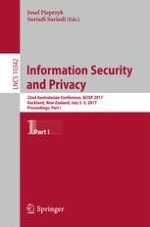The two volume set LNCS 10342 and 10343 constitutes the refereed Proceedings of the 22nd Australasian Conference on Information Security and Privacy, ACISP 2017, held in Auckland, New Zealand, in July 2017. The 45 revised full papers, 2 keynotes, 8 invited papers and 10 short papers presented in this double volume, were carefully revised and selected from 150 submissions. The papers of Part I (LNCS 10342) are organized in topical sections on public key encryption; attribute-based encryption; identity-based encryption; searchable encryption; cryptanalysis; digital signatures. The papers of Part II (LNCS 10343) are organized in topical sections on symmetric cryptography; software security; network security; malware detection; privacy; authentication; elliptic curve cryptography.
